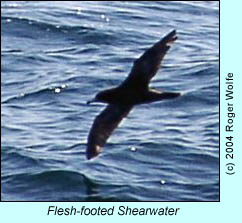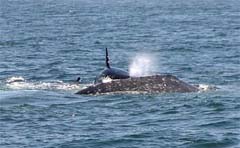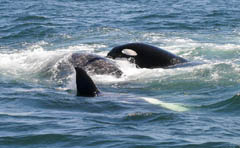Sunday May 9, 2004 -- Killers of Mother's Day
It was pure pleasure to arrive at the dock on Mother's Day
on a fog-free morning. Being May we knew in all likelihood the afternoon
would bring wind so we planned accordingly to get out to an area of
the Monterey Bay where we could bring it home with the wind at our
backs. On board we had the legendary Aussie seabirder Steve Anyon-Smith
who was chomping at the bit to get out in the bay to see some sea
monsters (as he likes to call them); he would not be disappointed
today.
Still inside the harbor we had our only COMMON LOON. The breakwater
was topped with more than 200 nesting BRANDT'S CORMORANTS.
We found no rocky shorebirds along the jetty. PIGEON GUILLEMOTS
were seen along Cannery Row, as were a few PELAGIC CORMORANTS
and our first of many PACIFIC LOONS.
Off of Cypress Point there was a great deal of shearwater activity.
Good numbers of SOOTY SHEARWATERS both in flight and resting
on the water, looking a bit ratty in post migratory molt. Also making
a good showing were an estimated 75 PINK-FOOTED SHEARWATERS
and several small flocks of RED-NECKED PHALAROPES.
 About
mid morning things cut loose all at once when our first BLACK-FOOTED
ALBATROSS appeared and a few moments later in came a very obliging
FLESH-FOOTED SHEARWATER, our first of three on the day.
About
mid morning things cut loose all at once when our first BLACK-FOOTED
ALBATROSS appeared and a few moments later in came a very obliging
FLESH-FOOTED SHEARWATER, our first of three on the day.
Some very full alcids were found attempting to fly away with full
crops; several CASSIN'S and a few RHINOCEROS AUKLETS
as well as a good number of COMMON MURRES. At one point Steve
Anyon-Smith hollers what sounds to our Yank ears like "Whyle!" and
it takes a moment for us to translate from Aussie. Our first two HUMPBACK
WHALES blow. As we approach I'm in the top drive when I hear folks
in the back gasp. Leader Richard Ternullo says, "must have breached."
Sure enough it does again, completely clearing the water, right side
up like a giant dolphin! I've seen many humpbacks do this from a distance
but this guy is only 50-75 yards away. Quite a thrill. This whale
breaches a few more times much to the delight of all on board.
About this time we get a call from Killer Whale researcher Nancy Black
of Monterey Bay Whale Watch that she has found a pod of KILLER WHALES
attempting to separate a GRAY WHALE calf from its mother just off
of Moss Landing. It is about 17 miles away but we decide to go for
it. It's a bit of a haul as the wind begins to pick up. En route we
come across a BLUE WHALE that dives and we are too impatient to wait
for it to resurface as everyone on board really wants to see the Killer
Whales in action. We also find a few NORTHERN FULMARS along
the way.
Finally as we arrive just off of the harbor entrance to Moss Landing
we see a great deal of commotion. A pod of 15 KILLER WHALES is playing
tag team against the Gray Whale mother and her calf. Mom does her
damnedest to keep the calf out of harm's way. Rolling onto her back
with the calf on her chest, she tries to protect it from the onslaught.
But the KWs are determined and we see the calf take some intense head
butts to the body.
These digital images were shot at 7.5 frames per second. This series
shows the calf being butted by a female killer whale. Click on one
of these images to see a larger version of the four photos in sequence.
The KWs take turns in teams trying to slam into the calf or push
it under the water to drown it. The mother and calf are blowing about
every 15 seconds which is the whale equivalent of panting. There is
one huge male KW that uncharacteristically takes part in the hunt;
typically they let the female do the work, much like African Lions.
The vertical height of his dorsal fin and overall size in comparison
to the females is very impressive.
We see only a bit of blood coming from one of the pectoral fins of
the calf otherwise the attack appears to consist of blows and attempts
at separation. The mother Gray Whale does her best, placing her body
between the KWs and the calf, and she slashes the water with her flukes
trying to get a shot in. On the boat we are all in awe of the spectacle
we are witness to. Veteran seabird leaders Don Roberson and Steve
Bailey have never seen the likes of anything like this. I fill up
the card on my digital camera all too soon.
 |
|
 |
| Photo by Roger Wolfe |
|
Photo by Jeff Poklen |
All of us are on the bow listening to Richard Ternullo answer questions
about Killer Whales and their attack strategies. They favor this particular
spot in the Monterey Bay as the deep submarine canyon comes very close
to shore here. The Gray Whale mothers and calves on their northern
return from the Baja lagoons like to hug the shoreline to avoid the
KWs. Sooner or later they'll have to cross over the deep water of
the canyon here and the KWs know that.
 |
| Photo by Roger Wolfe |
To us it looks as if the calf has virtually no chance of surviving
this attack given the intensity and numbers of KWs and by the time
we have arrived this has already gone on for hours. Someone asks if
they ever get away and Richard tells us if the mother and calf can
get into water less than 60 feet deep they have a good chance of getting
away. The next question is how deep is it here? About 60 feet is the
answer.
Suddenly there is a break in the action as the KWs switch teams. The
team resting on the sidelines is a little slow in reasserting the
attack and the mother and calf head for shore. There is a brief flurry
of activity and the KWs break off the attack and take off into the
bay. The mother and calf get away. How appropriate for Mother's Day!
We follow the fleeing KWs for a while and have great looks at them
leaping beside the boat. Just an incredible experience to savor.
Other birds seen but not mentioned above: BROWN PELICAN, CALFORNIA,
WESTERN and BONAPARTE'S GULLS and CASPIAN TERN.
Read more about the Killer Whale attack and see additional photos
on Don
Roberson's website.
Roger Wolfe for Monterey
Seabirds
